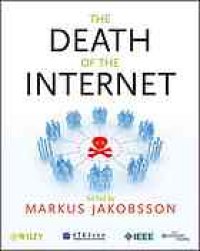
Ebook: The death of the internet
Author: Markus Jakobsson
- Year: 2012
- Publisher: John Wiley & Sons
- City: Hoboken
- Language: English
- pdf
Fraud poses a significant threat to the Internet. 1.5% of all online advertisements attempt to spread malware. This lowers the willingness to view or handle advertisements, which will severely affect the structure of the web and its viability. It may also destabilize online commerce. In addition, the Internet is increasingly becoming a weapon for political targets by malicious organizations and governments. This Read more...
Content: THE DEATH OF THE INTERNET; Contents; Foreword; Preface; Is the Title of this Book a Joke?; Acknowledgments; Contributors; Part I The Problem; 1 What Could Kill the Internet? And so What?; 2 It is About People; 2.1 Human and Social Issues; 2.1.1 Nigerian Scams; 2.1.2 Password Reuse; 2.1.3 Phishing; 2.2 Who are the Criminals?; 2.2.1 Who are they?; 2.2.2 Where are they?; 2.2.3 Deep-Dive: Taking a Look at Ex-Soviet Hackers; 2.2.4 Let's try to Find Parallels in the World we Live in; 2.2.5 Crime and Punishment?; 3 How Criminals Profit; 3.1 Online Advertising Fraud; 3.1.1 Advertising on the Internet. 3.1.1.1 Ad serving architecture3.1.1.2 Targeted advertising; 3.1.1.3 Revenue models; 3.1.2 Exploits of Online Advertising Systems; 3.1.2.1 Adversary; 3.1.2.2 Ad Fraud; 3.1.3 Click Fraud; 3.1.3.1 Case study: advertisers scammed by porn sites; 3.1.3.2 Countermeasures to fight click fraud; 3.1.4 Malvertising: Spreading Malware via Ads; 3.1.4.1 Countermeasures to fight malvertising; 3.1.5 Inflight Modification of Ad Traffic; 3.1.5.1 Countermeasures to fight inflight modification of ad traffic; 3.1.6 Adware: Unsolicited Software Ads; 3.1.6.1 Countermeasures to fight adware; 3.1.7 Conclusion. 3.2 Toeing the Line: Legal but Deceptive Service Offers3.2.1 How Does it Work?; 3.2.2 What do they Earn?; 3.3 Phishing and Some Related Attacks; 3.3.1 The Problem is the User; 3.3.2 Phishing; 3.3.3 Man-in-the-Middle; 3.3.4 Man-in-the-Browser; 3.3.5 New Attack: Man-in-the-Screen; 3.4 Malware: Current Outlook; 3.4.1 Malware Evolution; 3.4.1.1 Malware categories; 3.4.1.2 Malware example; 3.4.1.3 Polymorphic malware; 3.4.2 Malware Supply and Demand; 3.4.2.1 The malware industry; 3.4.2.2 Malware supply chain; 3.5 Monetization; 3.5.1 There is Money Everywhere; 4 How Things Work and Fail. 4.1 Online Advertising: With Secret Security4.1.1 What is a Click?; 4.1.2 How Secret Filters are Evaluated; 4.1.2.1 Third-party click scoring; 4.1.2.2 Ad network check: new filter, old clicks; 4.1.2.3 Ad network check: old filter, new clicks; 4.1.3 What do Fraudsters Know?; 4.2 Web Security Remediation Efforts; 4.2.1 Introduction; 4.2.2 The Multitude of Web Browser Security Mechanisms; 4.2.2.1 Web browser-based built-in security mechanisms; 4.2.2.2 Selectively invocable browser-based security mechanisms; 4.2.2.3 Advanced browser-based web security mechanisms; 4.2.3 Where do we go from Here? 4.3 Content-Sniffing XSS Attacks: XSS with Non-HTML Content4.3.1 Introduction; 4.3.2 Content-Sniffing XSS Attacks; 4.3.2.1 Content-sniffing; 4.3.2.2 A detailed view of content-sniffing XSS attacks; 4.3.2.3 Why do mismatches happen?; 4.3.2.4 Finding content-sniffing XSS attacks; 4.3.2.5 Example 1: Under the hood of the HotCRP attack; 4.3.2.6 Example 2: An attack on wikipedia; 4.3.3 Defenses; 4.3.3.1 Server-side defenses; 4.3.3.2 Secure content-sniffing; 4.3.3.3 Adoption; 4.3.4 Conclusion; 4.4 Our Internet Infrastructure at Risk; 4.4.1 Introduction; 4.4.2 The Political Structure.
Abstract:
Covering internet security, malware, phishing, and how to combat these serious and growing issues on both desktop and smart phone platforms, this book draws upon state-of-the-art research from Read more...
Download the book The death of the internet for free or read online
Continue reading on any device:

Last viewed books
Related books
{related-news}
Comments (0)